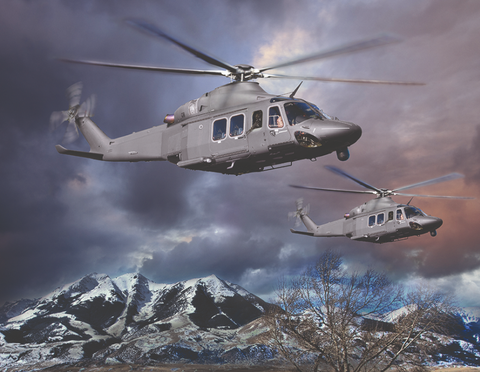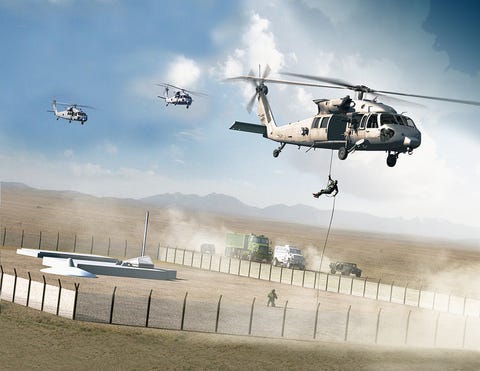The Air Force Wants Helicopters to Help Defend Nuclear Missiles
The helos would carry rapid reaction security troops.
By Kyle Mizokami LEONARDO/BOEING
LEONARDO/BOEINGThe U.S. Air Force is looking for a new armored helicopter capable of transporting security troops to nuclear missile silos. The competition has drawn three entrants, including two types of Blackhawk helicopter and a European design offered in cooperation with Boeing.
The United States has 400 Minuteman III intercontinental ballistic missiles on alert across the western United States. Sixty feet long and weighing more than 37 tons, each Minuteman III carries a 300 kiloton thermonuclear warhead and has a range of more than 8,000 miles, enough to strike any target in the Northern Hemisphere. The missiles sit in reinforced concrete and steel silos in Wyoming (Warren Air Force Base), Montana (Malmstrom Air Force Base, and North Dakota (Minot Air Force Base.) Each silo is unmanned, with up to ten silos controlled by a nearby manned Launch Control Center.
Security is generally excellent but the spread-out nature of the missile fields means they are isolated. The fact that they control nuclear weapons makes them potential targets to anyone from anti-nuclear protesters to special forces troops and saboteurs. To deal with such situations, the Air Force has special security teams trained to fly in by helicopter and secure a threatened missile site.
The Achilles Heel of the security teams are their helicopters—old, slow UH-1N Hueys. They’re the last Hueys in the Pentagon’s inventory, and the Air Force would like to replace them. The service is seeking 84 replacement helicopters. Sikorsky is offering new UH-60U Blackhawk helicopters, while European defense contractor Leonardo has teamed up with Boeing to offer the MH139. A third contractor, Sierra Nevada, is offering surplus Army Blackhawk helicopters updated to a modern standard.

Sikorsky’s HH-60U helicopter.
SIKORSKY
Sikorsky’s entrant, the HH-60U, is already in U.S. Air Force service and, according to DefenseNews, the odds-on favorite to win. The HH-60U has a rescue hoist, internal fuel storage, and a forward looking infrared sensor for detecting objects on the ground. Sikorsky says that buying more HH-60Us will make them cheaper to operate, as a single depot could service the entire helicopter fleet.
Leonardo/Boeing’s entrant, the MH139 (see above), is based on the AugustaWestland AW139 helicopter. The AW139 is roughly equivalent to the UH-60 series in size, carrying capacity, and performance. Boeing claims that the MH139 could save up to $1 billion in acquisition costs and lifecycle expenses.

Sierra Nevada’s Sierra Force helicopter.
SIERRA NEVADA CORP.
The third entry is Sierra Nevada Corporation and its updated Blackhawks. Sierra Nevada plans to buy surplus, obsolete UH-60A Blackhawk helicopters, strip them down to their frames, and rebuild them to the Pentagon’s UH-60L standard. The upgraded helicopters would get new General Electric Aviation T-701D engines, glass cockpits, and mission equipment. The company would also give all intellectual property to the Air Force, allowing the service to shop around and contract someone else do maintenance for the lifetime of the helicopter fleet.
The Air Force is expected to sign a contract with one of the three companies this year, and it’s difficult to tell who will win. Sikorsky’s offering will be one of the most expensive up front, but the service already has UH-60Us and that makes it an easier sell. Leonardo/Boeing’s offering promises up to a billion in savings. Sierra Nevada’s approach is fairly radical—the Air Force doesn’t like buying second hand planes, but the aircraft will essentially be new, inexpensive, and not saddled with older, more expensive to maintain systems.
All three companies are hyping cost savings as a major advantage, and looking at the Air Force’s long term budget profile it’s not hard to see why. In addition to annual purchases of the F-35A Joint Strike Fighter in the coming years the Air Force will begin to purchase the T-X jet trainer, the B-21 Raider bomber, develop a new intercontinental ballistic missile (Ground Based Strategic Deterrent) and start work on a sixth generation fighter, Penetrating Counter Air. It’s not exactly clear how the service will pay for all of this without a major funding increase.
One thing is for sure, though: If the Air Force continues with the policy of sprinkling 400 hydrogen bombs across the country in underground silos, those nukes need the best protection possible, and a new helicopter is essential in providing adequate security.
No comments:
Post a Comment